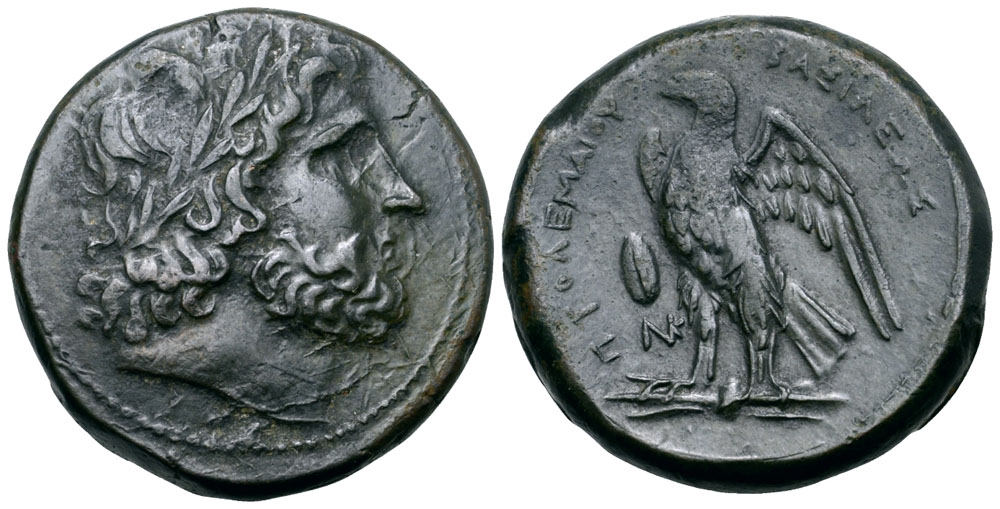Syracuse (Hieron II), bronze (17.5g) (Zeus/eagle on thunderbolt) (263-260 BCE)
From SILVER
263 BCE - 260 BCE Bronze
Description
| ObverseInscription or printing placed on the obverse.: | Laureate head of Zeus right |
| ReverseInscription or printing placed on the reverse.: | ΠΤΟΛΕΜΑΙΟΥ ΒΑΣΙΛΕΩΣ (Greek).Eagle standing left on thunderbolt, with wings spread, Galatian shield to left, NK below shield |
Mint and issuing power
| MintIdentifies the place of manufacture or issue of a numismatic object.: | Syracuse | Ancient regionAncient region.: | Sicily | Modern countryModern country: Italy | AuthorityIdentifies the issuing power. The authority can be "pretended" when the name or the portrait of X is on the coin but he/she was not the issuing power. It can also be "uncertain" when there is no mention of X on the coin but he/she was the issuing power according to the historical sources: | Hieron II of Syracuse (tyrant of Syracuse, 270-215 BC) |
Chronology
| FromIdentifies the initial date in a range assigned in a numismatic context. | 263 BCE | toIdentifies the final date in a range assigned in a numismatic context.. | 260 BCE | PeriodTime period of the numismatic object.: Hellenistic 323-30 BC |
Physical description
| MetalThe physical material (usually metal) from which an object is made.: | Bronze |
Median weightMedian of the weights of numismatic objects (in grams). in grams | 17.50 | DenominationTerm indicating the value of a numismatic object. Examples: tetradrachm, chalkous, denarius.: | obol |
StandardStandard.: |
Image

Syracuse_Galatian_shield_Hieron.jpg [1]
References
| Die study referencePublication of the study: | Wolf - Lorber 20111Wolf - Lorber 2011 | ||
| Coin series referenceReference to coin series study: | Svoronos 1904-19082Svoronos 1904-1908, n° 612, 615, 619, 620, 623, 624, CPE I3CPE I, n° B291-298 | ||
| Coin series web referenceCoin series web references: |
| ||
Obverse dies distribution
| FrequencyFrequency of specimen in distribution. ᵖ | Number of obversesNumber of obverse dies. ᵖ (o) | % (o) | Number of coinsNumber of coins. (n) | % (n) | Die nameName(s) of the die(s). |
| 1 | 36 | 65.45 | 36 | 33.64 | 2, 5, 6, 7, 8, 9, 10, 13, 16, 17, 18, 21, 22, 23, 24, 25, 26, 28, 29, 31, 32, 33, 34, 35, 36, 37, 40, 41, 44, 49, 50, 51, 52, 53, 54, 55 |
| 2 | 5 | 9.09 | 10 | 9.35 | 3, 11, 19, 20, 30 |
| 3 | 6 | 10.91 | 18 | 16.82 | 4, 12, 15, 27, 39, 48 |
| 4 | 4 | 7.27 | 16 | 14.95 | 14, 38, 46, 47 |
| 5 | 2 | 3.64 | 10 | 9.35 | 42, 45 |
| 8 | 1 | 1.82 | 8 | 7.48 | 1 |
| 9 | 1 | 1.82 | 9 | 8.41 | 43 |
| Total | 55 of 55 | 100 | 107 of 107 | 100 |
Reverse dies distribution
no distribution is available
Quantification
| Number of obversesNumber of obverse dies. ᵖ (o) | 55 | Number of singletons (o1)The number of singleton coins. ᵖ | 36 |
| Number of reverse diesNumber of reverse dies. (r) | 94 | Number of coinsNumber of coins. (n) | 107 |
| Coins per obverse dieNumber of coins per obverse die. (n/o) | 1.95 | Coins per reverse dieNumber of coins per reverse die. (n/r) | 1.14 |
| Reverse per obverse ratioRatio of obverse dies divided by reverse dies. (r/o) | 1.71 | Percentage of singletons (o1)number of coins (n) divided by the number of singletons (o1) ᵖ | 65.45 % |
| Original number of dies (O) (Carter 1983 formula)The estimation of the number of coins according to Carter 1983 ᵖ | 91.86 | Coins struck if 20,000 as average productivity per dieCoins made if the average productivity for obverses (according to Carter) is 20,000. ᵖ | 1,837,200 |
| Original number of dies (O) (Esty 2011 formula)The estimation of the number of coins according to the singleton formula in Esty 2011 ᵖ (O) | 113.17 | Survival rate if 20,000 as average productivity per dieSurvival rate if average productivity is 20,000. ᵖ | 0.00006 |
| Coverage (o = % of O) (Esty 1984 formula)Esty 1984 - coverage (% of O) ᵖ (o = % of O) | 66.36% | Die productivity if survival rate 1/2,000Average productivity if survival rate is 1/2,000. ᵖ | 2,329.63 |
| Weight of silver (in kg) if 20,000 coins per die (O = Carter formula)Carter 1983 * Median weight * 20000 (*10 if gold or electrum) ᵖ | n.a. | Die productivity if survival rate 1/5,000Average productivity if survival rate is 1/5,000. ᵖ | 5,824.08 |
Remarks
Most likely one single workstation
References
- ^ Wolf, Daniel - Lorber, Catharine C. (2022), "The ‘Galatian Shield without 2’ Series of Ptolemaic Bronze Coins," Numismatic Chronicle, 171, p. 7-53, pl. 1-3.
- ^ Svoronos, Ioannes N. (1904-1908), Τὰ νομίσματα τοῦ κράτους τῶν Πτολεμαίων (Ta nomismata tou kratous tōn Ptolemaiōn - The coins of the Ptolemaic rulers), Athens, 4 v., 68 pl.
- ^ Lorber, Catharine C. (2018), Coins of the Ptolemaic empire : Part I. Ptolemy I through Ptolemy IV, 2 vol., New York.